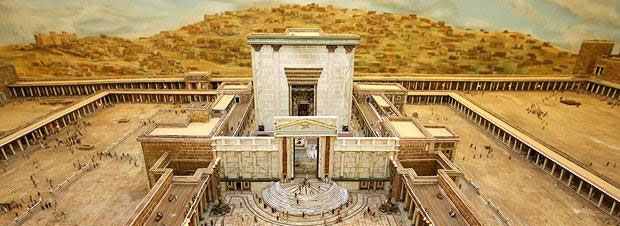Ancient Israelite Temples Timeline (1300 BC—AD 100)

Ancient Israelite Temples Timeline (1300 BC—AD 100) by Bryce Haymond is licensed under a Creative Commons Attribution-Share Alike 3.0 United States License. That means you can use this graphic however you please, as long as you attribute the original work to me and this website, and any derivatives must be licensed the same. See the Creative Commons link above for more details.
I am a visual learner in many ways, so sometimes I like to put things together visually so I can get a better grasp of them, and understand them more thoroughly. The history of the ancient Israelite temples is one of those things that I wanted to learn better, so I created this timeline to help me visualize it.
The timeline shows the basic history of the ancient Israelite temples from the Tabernacle of Moses, through Solomon’s Temple (First Temple Period), the Babylonian Exile, and Zerubbabel’s and Herod’s Temples (Second Temple Period). This spans about 1400 years. Major temple structures are noted, as well as lesser known Israelite temples. Major events which affected temple worship are marked and labeled, as well as other important dates.
The information on the timeline is sourced primarily from William Hamblin and David Seely’s excellent 2007 book, Solomon’s Temple: Myth and History (pages 9-49, 210). Other information was found at various sources online.
I’m sure there are many details I’ve left out, and probably some errors. If there are items that you think should be included (such as additional Israelite temples), please let me know. If there are errors, please tell me those as well. Just leave notes in the comments, and I will continually update the timeline here as I receive feedback. Thanks!
Update (10/31/2009): I’ve updated the timeline. I’ve added some temples in the New World, including the temple in the city of Nephi, Zarahemla, and Bountiful. I’ve also added several more Old World temples including Arad, Meggido, Lachish, Beersheba, Gilgal, Ebal, Shechem, Shiloh, Kirjath-jearim, and Gibeon. Many of the dates are approximated. There are still more to add, as soon as I find more details.
Update (11/2/2009): I’ve decided to make this strictly an Old World temples timeline, so I’ve removed the few references to temples in the New World. I may make a separate timeline which compiles what we know of temples in the Book of Mormon. I’ve added some details about the ruling parties in Judea between 515 BC and AD 100. I’ve also added a visual reconstruction of what the Elephantine Temple may have looked like. Other small details have also been added.



 One of the criticisms leveled at the LDS (Mormon) practice of temple worship is the seemingly dissimilar forms of the ordinances when compared with those found practiced by ancient Israelites in the Bible. It is true that the forms of the ordinances and sacrifices are different, but their meaning and symbolism remain the same. Let us consider why the forms are different.
One of the criticisms leveled at the LDS (Mormon) practice of temple worship is the seemingly dissimilar forms of the ordinances when compared with those found practiced by ancient Israelites in the Bible. It is true that the forms of the ordinances and sacrifices are different, but their meaning and symbolism remain the same. Let us consider why the forms are different.